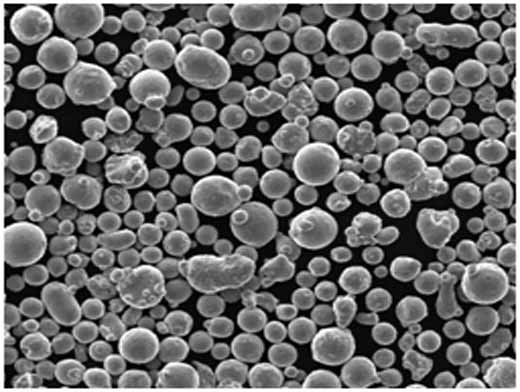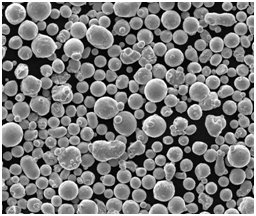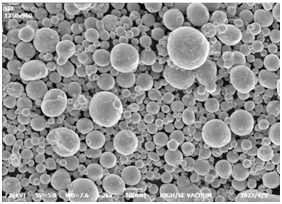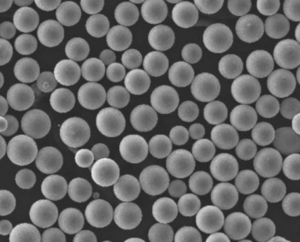Refraktärmetallpulver sind ein faszinierender und wesentlicher Bestandteil der modernen Materialwissenschaft und spielen eine entscheidende Rolle in verschiedenen High-Tech-Industrien. Diese Materialien sind für ihre außergewöhnliche Beständigkeit gegen Hitze und Verschleiß bekannt, was sie in anspruchsvollen Anwendungen unschätzbar macht. In diesem umfassenden Leitfaden werden wir tief in die Welt der Refraktärmetallpulver eintauchen und ihre Arten, Zusammensetzungen, Eigenschaften, Anwendungen und vieles mehr untersuchen.
Überblick über Refraktärmetallpulver
Refraktärmetallpulver werden aus Elementen gewonnen, die außergewöhnlich hohe Schmelzpunkte aufweisen und beständig gegen Verschleiß, Korrosion und Verformung sind. Zu diesen Metallen gehören Wolfram, Molybdän, Tantal, Niob und Rhenium. Sie werden in Umgebungen eingesetzt, in denen Materialien benötigt werden, die extremen Bedingungen standhalten können, wie z. B. in der Luft- und Raumfahrt, in Kernreaktoren und in Hochtemperaturöfen.

Arten von Refraktärmetallpulvern
Um Refraktärmetallpulver vollständig zu verstehen, wollen wir uns einige spezifische Arten und ihre einzigartigen Eigenschaften genauer ansehen:
| Metall | Beschreibung |
|---|---|
| Tungsten (W) | Bekannt für den höchsten Schmelzpunkt und die höchste Dichte, ideal für Hochtemperaturanwendungen. |
| Molybdän (Mo) | Ausgezeichnete Wärmeleitfähigkeit und geringe Wärmeausdehnung, Verwendung in Elektronik und Beleuchtung. |
| Tantal (Ta) | Hoch korrosionsbeständig, Verwendung in medizinischen Geräten und chemischen Verarbeitungsanlagen. |
| Niobium (Nb) | Hohe Duktilität und Supraleitfähigkeit, Verwendung in Superlegierungen und Elektronik. |
| Rhenium (Re) | Hoher Schmelzpunkt und einzigartige elektrische Eigenschaften, Verwendung in Strahltriebwerken und Elektronik. |
| Zirkonium (Zr) | Ausgezeichnete Korrosionsbeständigkeit und Festigkeit, Verwendung in Kernreaktoren und medizinischen Implantaten. |
| Hafnium (Hf) | Hohe Neutronenabsorption, Verwendung in Kernreaktoren und Luft- und Raumfahrtkomponenten. |
| Vanadium (V) | Gute Festigkeit und Temperaturbeständigkeit, Verwendung in Superlegierungen und Werkzeugen. |
| Chrom (Cr) | Ausgezeichnete Härte und Korrosionsbeständigkeit, Verwendung in Beschichtungen und Superlegierungen. |
| Titan (Ti) | Hohes Verhältnis von Festigkeit zu Gewicht, Verwendung in der Luft- und Raumfahrt, in der Medizin und in industriellen Anwendungen. |
Zusammensetzung der Pulver aus hochschmelzenden Metallen
Die Zusammensetzung von Refraktärmetallpulvern ist entscheidend für ihre Leistung. Diese Metalle werden oft mit anderen Elementen kombiniert, um bestimmte Eigenschaften zu verbessern:
| Metall | Zusammensetzung | Eigenschaften verbessert |
|---|---|---|
| Tungsten | Rein oder legiert mit Ni, Fe, Cu | Verbesserte Bearbeitbarkeit und Festigkeit. |
| Molybdän | Rein oder legiert mit Ti, Zr, C | Verbesserte Kriechbeständigkeit und Festigkeit. |
| Tantal | Rein oder legiert mit W, Hf | Verbesserte Korrosionsbeständigkeit und Festigkeit. |
| Niobium | Rein oder legiert mit Ti, Al | Verbesserte Supraleitfähigkeit und Festigkeit. |
| Rhenium | Rein oder legiert mit Mo, W | Verbesserte thermische Stabilität und Festigkeit. |
Eigenschaften von Refraktärmetallpulvern
Refraktärmetallpulver weisen einzigartige Eigenschaften auf, die sie für Hochleistungsanwendungen geeignet machen:
- Hohe Schmelzpunkte: Unverzichtbar für Anwendungen mit extremer Hitze.
- Außergewöhnliche Härte: Sorgt für Haltbarkeit und Verschleißfestigkeit.
- Hohe Dichte: Trägt zur Festigkeit und Stabilität unter Belastung bei.
- Korrosionsbeständigkeit: Gewährleistet Langlebigkeit in rauen Umgebungen.
- Gute Wärme- und elektrische Leitfähigkeit: Wichtig für Elektronik und Hochtemperaturanwendungen.






Anwendungen von Refraktärmetallpulvern
Refraktärmetallpulver werden aufgrund ihrer bemerkenswerten Eigenschaften in verschiedenen Branchen eingesetzt:
| Industrie | Anmeldung |
|---|---|
| Luft- und Raumfahrt | Strahltriebwerkskomponenten, Raketendüsen, Hitzeschilde. |
| Elektronik | Halbleiterbauelemente, Filamente, Kontakte. |
| Medizinische | Chirurgische Instrumente, Implantate, zahnmedizinische Geräte. |
| Kernkraft | Reaktorkomponenten, Strahlungsschild, Brennstoffummantelung. |
| Chemische Verarbeitung | Korrosionsbeständige Ausrüstung, Katalysatoren, Reaktionsbehälter. |
| Industriell | Schneidwerkzeuge, Formen, Matrizen, verschleißfeste Beschichtungen. |
Spezifikationen, Größen, Güteklassen, Normen
Das Verständnis der Spezifikationen und Standards für Refraktärmetallpulver ist für ihre Anwendung von entscheidender Bedeutung:
| Metall | Größen (Mikrometer) | Klassen | Normen |
|---|---|---|---|
| Tungsten | 1-100 | W1, W2, W3 | ASTM B777, ISO 4497 |
| Molybdän | 1-50 | Mo1, Mo2, TZM | ASTM B386, ISO 5755 |
| Tantal | 1-40 | Ta1, Ta2 | ASTM B708, ISO 13782 |
| Niobium | 1-60 | Nb1, Nb2, Nb3 | ASTM B393, ISO 13782 |
| Rhenium | 1-20 | Re1, Re2 | ASTM B708, ISO 13782 |
Lieferanten und Preisangaben
Die Suche nach zuverlässigen Lieferanten und das Verständnis der Preise sind für die Beschaffung unerlässlich:
| Anbieter | Metall | Preis (pro kg) | Kontaktinformationen |
|---|---|---|---|
| Global Tungsten | Tungsten | $250 | [email protected] |
| Midwest Molybdenum | Molybdän | $150 | [email protected] |
| Tantalum Supply | Tantal | $300 | [email protected] |
| Niobium Sources | Niobium | $200 | [email protected] |
| Rhenium Rare | Rhenium | $400 | [email protected] |
Vorteile und Einschränkungen von Refraktärmetallpulvern
Obwohl Refraktärmetallpulver viele
| Vorteile | Beschränkungen |
|---|---|
| Hohe Temperaturbeständigkeit | Hohe Kosten |
| Excellent mechanical strength | Schwierig zu bearbeiten |
| Hervorragende Korrosionsbeständigkeit | Begrenzte Verfügbarkeit |
| Gute elektrische und thermische Leitfähigkeit | Heavy and dense |
| Long-lasting and durable | Potential health hazards during handling |
Comparison of Refractory Metal Powders
When choosing between different refractory metal powders, it’s important to compare their properties and suitability for specific applications:
| Metall | Schmelzpunkt (°C) | Dichte (g/cm³) | Korrosionsbeständigkeit | Wärmeleitfähigkeit (W/m-K) | Anwendungen |
|---|---|---|---|---|---|
| Tungsten | 3422 | 19.25 | Ausgezeichnet | 173 | Aerospace, electronics, lighting |
| Molybdän | 2623 | 10.28 | Gut | 138 | Electronics, glass melting, lighting |
| Tantal | 3017 | 16.65 | Überlegene | 57 | Medical devices, chemical processing |
| Niobium | 2477 | 8.57 | Gut | 54 | Superalloys, electronics, medical |
| Rhenium | 3186 | 21.02 | Ausgezeichnet | 48 | Jet engines, electronics, chemical |
Detailed Analysis of Specific Pulver aus hochschmelzenden Metallen
Now, let’s delve deeper into the specifics of some key refractory metal powders, highlighting their unique properties, applications, and benefits.
Wolframpulver
Tungsten powder is renowned for its incredibly high melting point and density. This makes it ideal for applications that require materials to withstand extreme temperatures and mechanical stress. Tungsten is commonly used in aerospace for jet engine components, in electronics for filaments, and in medical devices for radiation shielding.
Molybdän-Pulver
Molybdenum powder is known for its excellent thermal conductivity and low thermal expansion. These properties make it suitable for applications in electronics, such as heat sinks and transistors, as well as in lighting and glass melting industries. Molybdenum’s ability to maintain strength at
Tantal-Pulver
Tantalpulver zeichnet sich durch seine überragende Korrosionsbeständigkeit aus. Dies macht es in der chemischen Verarbeitung und in medizinischen Anwendungen unentbehrlich. Tantal wird häufig in chirurgischen Instrumenten, Implantaten und in Geräten verwendet, die mit stark korrosiven Substanzen umgehen. Seine Fähigkeit, Korrosion zu widerstehen, gewährleistet Langlebigkeit und Zuverlässigkeit.
Niobium-Pulver
Niob-Pulver zeichnet sich durch seine hohe Duktilität und Supraleitfähigkeit aus. Dies macht es zu einer wesentlichen Komponente in Superlegierungen, die in der Luft- und Raumfahrt und in der Elektronik eingesetzt werden. Die supraleitenden Eigenschaften von Niob werden in medizinischen Bildgebungsgeräten und Teilchenbeschleunigern genutzt, wo die Aufrechterhaltung niedriger Temperaturen und eine effiziente Leistung entscheidend sind.
Rhenium-Pulver
Rhenium-Pulver wird für seinen hohen Schmelzpunkt und seine einzigartigen elektrischen Eigenschaften geschätzt. Es wird in Hochtemperatur-Turbinentriebwerken und in der Elektronik eingesetzt, die Materialien benötigen, die extremen Bedingungen standhalten können. Die außergewöhnliche thermische Stabilität und Festigkeit von Rhenium machen es zu einem kritischen Material in anspruchsvollen Umgebungen.
Vergleichende Analyse: Wolfram vs. Molybdän
Beim Vergleich von Wolfram mit Molybdän bieten beide Metalle eine hohe Temperaturbeständigkeit, aber der höhere Schmelzpunkt von Wolfram (3422 °C vs. 2623 °C) verschafft ihm einen Vorteil in Ultrahochtemperaturanwendungen. Die überlegene Wärmeleitfähigkeit und die geringere Dichte von Molybdän machen es jedoch zu einer besseren Wahl für Anwendungen, die eine effiziente Wärmeableitung und ein geringeres Gewicht erfordern.
Vergleichende Analyse: Tantal vs. Niob
Tantal und Niob zeichnen sich beide durch Korrosionsbeständigkeit aus, aber die höhere Dichte von Tantal (16,65 g/cm³ vs. 8,57 g/cm³) macht es besser geeignet für Anwendungen, bei denen das Gewicht weniger eine Rolle spielt und maximale Korrosionsbeständigkeit erforderlich ist. Die hohe Duktilität und Supraleitfähigkeit von Niob machen es jedoch zur bevorzugten Wahl für fortschrittliche Elektronik und Luft- und Raumfahrtanwendungen.
Vergleichende Analyse: Rhenium vs. Wolfram
Rhenium und Wolfram werden beide in Hochtemperaturanwendungen eingesetzt, aber die einzigartigen elektrischen Eigenschaften und der höhere Preis von Rhenium machen es ideal für spezielle Elektronik und Strahltriebwerke. Die höhere Dichte und die geringeren Kosten von Wolfram machen es praktikabler für allgemeine Hochtemperatur- und Hochfestigkeitsanwendungen.

FAQ
| Frage | Antwort |
|---|---|
| Was sind Refraktärmetallpulver? | Refraktärmetallpulver sind Materialien mit hohen Schmelzpunkten und außergewöhnlicher Beständigkeit gegen Hitze, Verschleiß und Korrosion. |
| Was sind einige gängige Anwendungen von Refraktärmetallpulvern? | Sie werden in der Luft- und Raumfahrt, in der Elektronik, in medizinischen Geräten, in Kernreaktoren und in chemischen Verarbeitungsanlagen eingesetzt. |
| Wie werden Refraktärmetallpulver hergestellt? | Sie werden typischerweise durch Verfahren wie mechanisches Legieren, chemische Gasphasenabscheidung und Reduktion von Metalloxiden hergestellt. |
| Was sind die wichtigsten Eigenschaften von Wolframpulver? | Wolframpulver ist bekannt für seinen hohen Schmelzpunkt, seine Dichte und seine Festigkeit, was es ideal für Hochtemperaturanwendungen macht. |
| Warum wird Molybdänpulver in der Elektronik verwendet? | Molybdänpulver hat eine ausgezeichnete Wärmeleitfähigkeit und eine geringe Wärmeausdehnung, wodurch es sich für Kühlkörper und elektronische Bauteile eignet. |
| Was macht Tantalpulver korrosionsbeständig? | Tantalpulver hat eine schützende Oxidschicht, die Korrosion selbst in rauen chemischen Umgebungen widersteht. |
| Wie wird Niob-Pulver in der Luft- und Raumfahrt eingesetzt? | Niob-Pulver wird in Superlegierungen für Strahltriebwerke und andere Hochleistungs-Luft- und Raumfahrtkomponenten verwendet, da es eine hohe Festigkeit und Duktilität aufweist. |
| Was sind die Vorteile der Verwendung von Rheniumpulver in der Elektronik? | Rheniumpulver bietet einzigartige elektrische Eigenschaften und eine hohe thermische Stabilität, was es ideal für Hochleistungs-Elektronikkomponenten macht. |
| Gibt es Gesundheitsrisiken im Zusammenhang mit der Handhabung von Refraktärmetallpulvern? | Ja, einige Refraktärmetallpulver können Gesundheitsrisiken bergen, wenn sie eingeatmet oder verschluckt werden. Bei der Handhabung und Verarbeitung sind geeignete Sicherheitsmaßnahmen zu treffen. |
| Wo kann ich Refraktärmetallpulver kaufen? | Refraktärmetallpulver können bei spezialisierten Lieferanten wie Global Tungsten, Midwest Molybdenum, Tantalum Supply, Niobium Sources und Rhenium Rare bezogen werden. |
Schlussfolgerung
Die Auswahl des geeigneten Refraktärmetallpulvers hängt von den spezifischen Anforderungen Ihrer Anwendung ab. Berücksichtigen Sie Faktoren wie Schmelzpunkt, Wärmeleitfähigkeit, Korrosionsbeständigkeit, Dichte und Kosten. Das Verständnis dieser Eigenschaften hilft Ihnen, eine fundierte Entscheidung zu treffen und den Erfolg Ihres Projekts zu gewährleisten.

